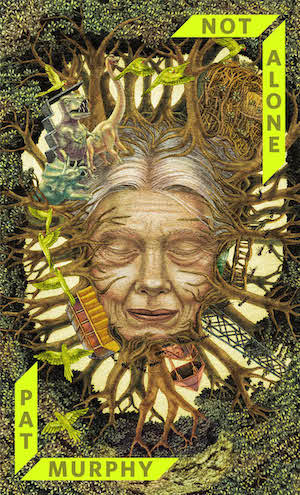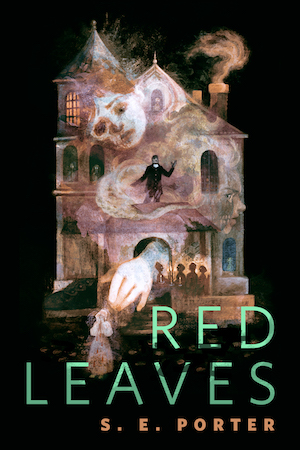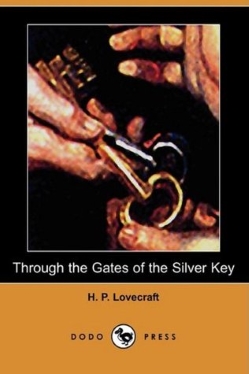Welcome back to the Lovecraft reread, in which two modern Mythos writers get girl cooties all over old Howard’s original stories.
Today we’re looking at “Through the Gates of the Silver Key,” written by Lovecraft and E. Hoffman Price between October 1932 and April 1933, and first published in the July 1934 issue of Weird Tales. You can read it here.
Spoilers ahead.
“There were “Carters” in settings belonging to every known and suspected age of earth’s history, and to remoter ages of earthly entity transcending knowledge, suspicion, and credibility. “Carters” of forms both human and non-human, vertebrate and invertebrate, conscious and mindless, animal and vegetable. And more, there were “Carters” having nothing in common with earthly life, but moving outrageously amidst backgrounds of other planets and systems and galaxies and cosmic continua. Spores of eternal life drifting from world to world, universe to universe, yet all equally himself.”
Summary: Four people meet in a New Orleans room featuring strange tapestries, tripod-censers burning olibanum—that’s frankincense to you—and a four-handed coffin-shaped clock that ticks in an alien rhythm and keeps no earthly time. Etienne de Marigny, a Creole occult scholar, and Ward Phillips, an eccentric Providence mystic, were close friends to vanished Randolph Carter. Ernest Aspinwall, apoplectic lawyer, is Carter’s cousin and potential heir. The fourth person is Swami Chandraputra, a bearded and turbaned Brahmin with an immobile face and burning black eyes. Though he speaks idiomatic English, his voice has a hollow, metallic quality. Why he wears mittens is anyone’s guess.
Carter disappeared after visiting the ruins of his ancestral home. He took along a silver key which he believed could lead him back to lost boyhood dreams. He left behind the hieroglyph-covered parchment found with the key. The four have the parchment now and debate how to handle Carter’s estate. Aspinwall’s eager for a settlement. The others don’t believe Carter’s dead, Phillips because he’s dreamed that Carter became king of Ilek-Vad in the Dreamlands. Aspinwall sneers, but Chandraputra says he too has dreamed and can tell what happened after Carter used the key.
He shares: The silver key opens a gate not to the Dreamlands Carter seeks, but a transdimensional chaos of ancestral memory. The pageant of impressions resolves into a space where ill-defined cloaked shapes squat on pedestals amid inverse geometry and light of no known color. One shape approaches. It is the dreadful ’UMR AT-TAWIL spoken of in the Necronomicon, Most Ancient One and Guide and Guardian of the Gate. Or Guide for short. It communicates via telepathic radiations, asking if Carter wishes to progress through the Ultimate Gate, or go back unharmed.
Encouraged by the friendliness of the Guide’s radiations, Carter decides to advance. With one mighty venture he can learn all, and damnation is but the babble of the sanctimonious blind!
The Guide and its cloaked companions perform a ritual of glowing and swaying and chanting, all in the crazy rhythm of that coffin-shaped clock. This carries Carter as in a sea of drugged wine through a titanic arch. In the Guide’s vestibule, he was still Randolph Carter. Beyond the Ultimate Gate, he becomes all the “Carters” that ever were, human and inhuman. At first he feels the terror of self-annihilation. Then a Being of ineffable majesty speaks to him. It’s the All-in-One and One-in-All sometimes called Yog-Sothoth. After again giving Carter a chance to retreat, the Being reveals the central truth of the cosmos. Space and time are illusions of a local, partial point-of-view. Limitless dimensions exist, and all that was or is or will be exists simultaneously. Outside the dimensions exist the “people of the ultimate abyss”—the archetypes. The Being itself is the Supreme Archetype, and know what? Carter is a local manifestation of IT, as are all the great wizards and artists and thinkers!
Carter realizes the Being could send him into any of his innumerable manifestations. He burns to walk in the flesh of one and chooses a tapir-snouted entity from a five-sunned planet. The Being warns Carter to be sure of the symbols that will allow him to return. Impatient, Carter assumes the key contains all the symbols he’ll need, and the Being sends him into the “Carter” known as Zkauba, wizard of Yaddith!
Unfortunately Carter’s imposed persona now wars with Zkauba’s. Too bad he was wrong about the key being enough—without that parchment he left in his car, he’s stuck! When Carter rules their squamous and clawed but vaguely humaniform body, he plots to return home. Ages pass before he concocts a way to drug the Zkauba persona and escape. He takes a “light-wave envelope” back to Earth and his own time, and dons a costume that lets him pass as human. He obtains a copy of the parchment and gets Chandraputra to help. Turns out it’s a translation from the original Hyperborean into R’lyehian! Carter and Chandraputra haven’t yet solved this linguistic puzzle. Ominously, Carter is running out of the drug that keeps Zkauba latent. Meanwhile, he’s learned about the settlement of his earthly estate and sent Chandraputra to assure the executors Carter’s still alive.
Aspinwall calls Chandraputra a madman and faker. He’s not impressed when Chandraputra produces the key itself and recent papers in Carter’s style. Why, the “Swami’s” probably not even East Indian! Isn’t that a mask?
Before the others can intervene, Aspinwall pulls off Chandraputra’s disguise. Both are shocked, Aspinwall into fatal apoplepsy, Chandraputra into inhuman buzzing. The others don’t see his revealed face, but as he shuffles toward the coffin-shaped clock and sheds one mitten, they glimpse a claw-shaped hand.
Chandraputra—Carter, Zkauba?—enters the clock. When de Marigny throws it open again, it’s empty.
Carter’s estate remains unsettled, and de Marigny and Phillips wonder whether Chandraputra might have hypnotized them into hallucinating that final horror. Yet de Marigny still listens with vague apprehension to the weird rhythms of that coffin-shaped clock that tells no earthly time.
What’s Cyclopean: A sculptured hand in the Arabian desert, the masonry of one of the key’s gates, and Martian ruins. For bonus points, the Yaddithians are both squamous and rugose!
The Degenerate Dutch: The only actual slur comes from a distinctly unsympathetic character, but exoticization runs rampant. Best example: Hindoos (sic) know much of hypnotism. Which makes perfect sense since Franz Mesmer, the art’s founder was… oh, wait, German. Never mind.
Mythos Making: The names are all here, but the entities seem surprisingly friendly—or at least, willing to pencil enlightenment-deserving sapients into their calendars. We do get a timeline on the future of the Carters, and a short tour of the outer solar system.
Libronomicon: Let the fate of that parchment fragment be a lesson to you—when entering a situation where you might spontaneously demand to inhabit your most alien aspect, always pack thoroughly.
Madness Takes Its Toll: The trials as Carter approaches Yog-Sothoth bring him close to madness. When you put it that way, it seems like he got off pretty easy.
Anne’s Commentary
Ah, the perils of the sequel. E. Hoffman Price admired “The Silver Key” so much he persuaded Lovecraft to edit his story about following Carter through that mysterious portal in the Snake-Den. Price claimed that Lovecraft changed much in his draft, adding about 8000 words and the Yaddith subplot; however, the central neoplatonic and theosophical elements are Price’s. The Dreamlands and Mythos get nods but are overwhelmed by all the talk of interdimensional sections and archetypes. I guess that occultist de Marigny represents Price, while Providence dreamer Ward Phillips represents Lovecraft. Usually I identify Randolph Carter with Lovecraft, but here Lovecraft really needs another avatar. It would be spectacularly egotistical to self-identify with someone who’s a local manifestation of the SUPREME ARCHETYPE, source of all great wizards and artists and thinkers! I mean, that makes being king of Ilek-Vad look like fingerling potatoes.
I have divided feelings about this one. The opening recap of “Silver Key” strikes me as less tiresome than Bloch’s recap of “Haunter” in “Shadow from the Steeple.” It adds a couple nice bits in the prints found below the Snake-Den after Carter’s disappearance: one set made by a little boy’s boots, the other set by curiously heelless boots such as those long-dead Benijah Corey wore. We also get to meet de Marigny, Carter’s WWI buddy, and Ward Phillips, revealed at last to be the narrator of “Silver Key.” In certain moods, I’d probably find tiresome the long middle section with its GUIDES and BEINGS and musings on reality and illusion. I didn’t mind it this time. It could be that tankard of Zoogish moon-wine I drank while reading, but I really got into the part about slicing a higher dimension to get the next lower dimension, like sectioning out a circle from a sphere. Deep. Very deep. More moon-wine please, with a chaser of that olibanum stuff, which turns out to be plain old frankincense, not even a proper hallucinogenic. Unless it is. I think heavily nutmegged eggnog would work better.
I do like the approach to an amoral universe that Price/Lovecraft take here. Carter realizes that the vast forces at the center of reality—the shapers of that reality—aren’t terrible daemon-sultans, after all. They aren’t indifferent to humanity. Not really. After all, each human is a local/temporal manifestation of an archetype, that is, of one of them. Kind of all cozy and connected for a change, once you get over that local/temporal prejudice for spreading the self over multiple-innumerable selves.
But, but, but. In a story for us mere local/temporals, how can you simply leave Carter floating around in the ultimate truth? Even if he can’t return to the throne of Ilek-Vad on which Phillips placed him, we’ve got to anchor him somewhere, space-and-time wise. So Lovecraft adds the Zkauba substory. Yaddith sounds like a cool place, what with its five multi-hued suns, its labyrinthine streets and its long struggle with the burrowing, viscous bholes. We don’t get enough of Yaddith, that’s the problem. It’s reminiscent of “Whisperer in Darkness” in the way a clawed alien with buzzing voice masquerades as a human. Reminiscent right down to that waxy and immobile mask. It also looks forward to “Shadow Out of Time” in the Carter-Zkauba dilemma. A mind leaps out of the future to (partially) take over the mind of a sapient from another species. This causes the possessed one troublesome dreams and pseudo-memories. It’s a little war of personae, far better explored in the later story, as is the coming cataclysm with subterranean monsters. Interesting to get that fore-glimmer of the Yith, though. [Ruthanna: Wait a sec. Yith… Yaddith… and they have amazing libraries… and they just got a close-up look at mind-switching time travel magic… Nah, couldn’t be. Could it?]
Also interesting how it takes really deep immersion in the Ultimate Truth to escape from singular selfdom. Carter takes a while to get used to the concept of infinite “Carters,” and then as soon as he leaves Ultimate Truth to hang out in a Yaddithian “Carter,” he wants to get back to Randolph Carter of Boston. And Zkauba wants to stay Zkauba. The One-in-All and All-in-One thing takes trans-, or extra-, or superdimensional mind expansion to stomach.
A nice psychological detail, actually, and it ties in to Lovecraft’s constant fascination for our reactions to the huge unknown. Terror and wonder, wonder and terror, alternating, co-existing, rarely in the perfect balance—or perfect freedom from terror—that Carter achieves so briefly, then lapses from.
The clock, now, yeah. Lovecraft or Price should have added that it wasn’t only coffin-shaped but coffin-sized, sort of a grandfather clock in scope. I imagined it much smaller and so was surprised when Zkauba-Carter just waltzed right in and shut the door. Maybe readers of an earlier age would have been more likely to imagine the grandfather’s clock when an elaborate timepiece was described. Whereas us moderns might be more likely to imagine an elaborate time-app on our cell phones?
My office clock has needed new batteries for a while. I check the corner of my screen for the time. But I can’t disappear into the corner of my screen, or at least not as dramatically as Zkauba-Carter disappears into the coffin-shaped clock.
My loss.
I want that clock now, crazy ticking and all.
Ruthanna’s Commentary
I was going to say that this is what happens when an author edits fanfic of their own stuff, but I’ve actually seen that done well in any number of shared world anthologies. So clearly, I’m just feeling grumpy because this… is not that thing. It’s like a movie made by a scriptwriter and director in the midst of an unresolved feud. Price stated that Lovecraft left barely 50 of his words in place. The words are Lovecraft’s for sure, but the cosmology isn’t. Instead, and to extremely weird effect, it seems to be the ordered universe of ceremonial magic, with enlightenment on offer for those brave enough to ask.
This story has three parts. I’m basically going to ignore the recap, neither the dullest nor the most scintillating I’ve ever read. I may have yawned a couple times, but then, I read “Silver Key” two weeks ago and can double-check online if I get fuzzy about details.
Then we get The Trance Journey of Randolph Carter. The dread keeper of the gate is awfully polite and accommodating. You know what Cthulhu basically never does? Double-checks whether you’re sure of your decision before responding to your approach. Color me underwhelmed by ‘UMR AT-TAWIL’s terrible and incomprehensible evilness. The threats to Carter’s identity are interesting, and seem in keeping with cosmic horror… until they’re revealed merely as the trials one must endure in order to have a nice conversation with Yog Sothoth. There was a moment where I thought this a parody of traditional ideas of enlightenment, suggesting that they mapped pretty well to the horrors of the Mythos… but nope, it’s just traditional ideas of enlightenment.
I’m never satisfied. Give me a narrator whinging at cosmic awareness in “Whisperer in Darkness,” and I want to know why he’s so damn horrified by the awesome. Give me “Randolph Carter Explains Crowley,” and I want to know why cosmic awareness is so cute and fuzzy. And then he meets his higher self, I can’t even. Thou art Yog-Sothoth?
I don’t want to diss on the Mythos/hermeticism crossover potential. I got through my last year of college on the Principia Discordia and the Illuminatus Trilogy and Robert Anton Wilson’s essays and then later there was Alan Moore and Grant Morrison and… Maybe “Gates” was trippier when you couldn’t buy 10 books on the inner mysteries of ‘20s ceremonial magic(k) in any book store? But even putting aside my younger self’s tendency to OD on mystic cosmology, I can’t help feeling that the best such crossovers either keep the horror horrifying (Illuminatus’s conspiracy to immanentize the eschaton), or put some things beyond the scale of even the most enlightened humans. Unless there are beings out there who don’t care what happens to any of us, it just doesn’t feel Mythosian to me.
Finally, we get Carter trying to undo his rashly made travel plans. I would happily read an entire story about his fraught relationship with Zkauba, especially in place of the story I actually just read. Unthinkable aeons and funky worldbuilding and OMG what’s that on Neptune and rugose wizards fighting giant sandworms, and deeply personal battles over identity within a single body. Only the barest outlines appear here, which is a shame—this part at least summarizes what could have been a great bit of later Lovecraft. Instead, Scooby Doo meets the Mythos, Carter’s poor host asserts his identity long enough to escape Earth’s horrors, and everyone stares mournfully at the clock. As do I, trying to figure out how many aeons I spent on this thing.
Fridge moment of the day: How does Carter have a descendant in 2169? Ded-of-the-Alienz dude is his closest living relative when he disappears—and isn’t a Carter, so presumably neither are his kids. So who carries on the family name/eternal continuity of identity?
Next week, join us for a psychological horror piece that isn’t remotely cute or fuzzy, in “The Tomb.”
Ruthanna Emrys’s neo-Lovecraftian novelette “The Litany of Earth” is available on Tor.com, along with the more recent but distinctly non-Lovecraftian “Seven Commentaries on an Imperfect Land.” Her work has also appeared at Strange Horizons and Analog. She can frequently be found online on Twitter and Livejournal. She lives in a large, chaotic household—mostly mammalian—outside Washington DC.
Anne M. Pillsworth’s short story “Geldman’s Pharmacy” received honorable mention in The Year’s Best Fantasy and Horror, Thirteenth Annual Collection. “The Madonna of the Abattoir” is published on Tor.com, and her first novel, Summoned, is available from Tor Teen. She currently lives in a Victorian trolley car suburb of Providence, Rhode Island.










